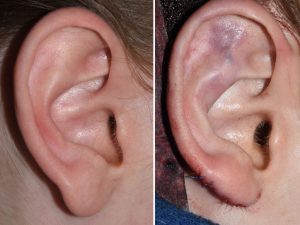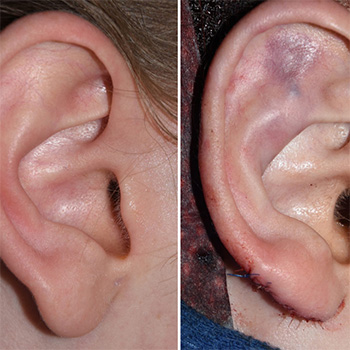Background: While everyone has an earlobe its shape is highly variable. Earlobe shapes vary significantly and are influenced by gender, age and overall ear sizes. While earlobe reshaping can be done by itself, it most frequently becomes part of an otoplasty ear reshaping. Ears that stick out frequently have earlobes that do also which can be simutaneously addressed.
The size proportion of the earlobe to the ear, or the non-cartilagous to cartilaginous part, is roughly 1/5 or 20% of the total ear length. When the earlobe occupies more ear real estate than that the earlobe will appear as large or too big. But beyond vertical length, there is also the earlobe width to consider. A more feminine earlobe will taper down to the side of the face keeping the total ear shape more narrow from top to bottom.
Case Study: This young transgender male to female was undergoing a variety of facial feminization procedures. One of the numerous procedures was to reshape her ear which stuck out and had a larger dangling earlobe that also stuck out.

Feminizing the earlobe is largely about reducing its size. It needs to be shrink down with in both length and width. The need to narrow it is what makes excision of the inferior helical rim the best approach to perform it.
Case Highlights:
1) The shape of the earlobe can be gender specific.
2) A more feminine earlobe is smaller both in length and width with a more tapered shape.
3) In reshaping the earlobe an inferior excisions technique is preferred.
Dr. Barry Eppley
Indianapolis, Indiana



